Executive Summary
Amid a landscape that has been dominated for nearly a decade by a select group of financial planning software heavyweights – MoneyGuidePro, Naviplan, and eMoney – newcomer RightCapital first launched in 2015 at the XY Planning Network conference. With an eye towards providing a simpler and easier-to-use interface and presenting solutions to clients in easy-to-understand reports, RightCapital (perhaps undeservedly) was labeled as a “light” financial planning software solution by industry publications. But in reality, RightCapital not only fills gaps left by other planning software providers around the intersection of retirement decumulation, tax planning, and Roth conversion strategies – that show, in dollars, the tangible value that financial advisors bring to the table – but also allows advisors to work with largely unserved next-generation client segments with its student loan planning capabilities, and to produce financial plans faster with its more collaborative planning capabilities. All of which has helped RightCapital in just 5 years since launch to jump to 4th in market share amongst financial planning software and, according to the latest Kitces Research study, see the biggest gains in market share for both broker-dealers and RIAs in the past two years.
In the guest post, Craig Iskowitz – CEO and founder of Ezra Group, a financial technology consulting firm – provides an in-depth software review of RightCapital, covering its features and benefits, interface, modules, client deliverables, and pricing.
In a crowded financial planning software marketplace, RightCapital differentiates itself by allowing advisors to help their clients with:
- Real-time collaborative planning around retirement planning and goal setting/scenarios by using “levers” to immediately show the dollar impact of different strategies (thus showing the tangible value of the advisor and fostering greater engagement),
- The tax impact of various decumulation strategies (whether proportional or sequential across different types of accounts) and the value of proactive tax planning through Roth conversions (for which RightCapital has been the only full-scale financial planning program in recent years to offer such in-depth capability),
- Detailed cashflow reporting and asset allocation modeling (thanks to their state-of-the-art calculation engine, which allows advisors to quickly flip through analytics tabs), and
- Using either a goals-based or cashflow-based planning approach depending on the client’s personal circumstances and advisor preferences.
RightCapital also offers a Social Security optimization and Student Loan planning modules, as well as accumulation planning and estate planning capabilities, though none of those features necessarily help the software stand out from other full-stack financial planning software providers or standalone vendors providing similar tools. And notably, while RightCapital has expanded its suite of available integrations with popular CRMs, reporting tools, and custodians, it still doesn’t have the breadth of integrations when compared to other providers (which means it’s important to check upfront if it integrates for any particular advisor’s tech stack).
Ultimately, most comprehensive financial planning software is ‘comprehensive’, which means ironically all the available solutions do so much it’s often difficult to differentiate at the margins which is really best at what. In the context of RightCapital, there are several areas that do stand out against its competitors, particularly when it comes to an attractive and intuitive user interface, real-time collaborative planning (and its speed to do calculations, which matters when clients are watching in real-time!), and the ability to choose either a goal-based or cashflow-based planning approach. However, RightCapital’s key differentiator is its detailed and tax-sensitive retirement distribution planning, which helps foster engagement between client and advisor, and importantly, demonstrates the actual dollar value that an advisor can offer… particularly in an environment where advisors are pressured to justify their fees. RightCapital may not offer all the robustness (or complexity) of eMoney, Naviplan, or MoneyTree, in certain areas, but it does provide powerful capabilities (especially for tax-savvy advisors) at an attractive price in a competitive marketplace.
RightCapital launched its first financial planning and tax-aware solution in September 2015, at the XY Planning Network national conference, with a mission to “create a solution using complex models to solve clients’ problems and present the results via a simple and intuitive interface.”
Today, RightCapital has gained enough market share to be included in our review of financial planning tools. According to the latest Kitces Research study, RightCapital ranked 4th based on 2019 market share statistics for financial planning software tools.
RightCapital has been labeled “financial planning – light but not too light” by industry publications. However, our analysis reveals that RightCapital is increasingly filling a void in planning software highlighted previously on this blog – software that accurately models retirement decumulation planning (as opposed to the traditional approach of planning for accumulation clients) – and delivers sophisticated retirement distribution analyses in an easy to understand manner for clients. After a thorough review of the application, the phrase “light but not too light” does not accurately describe the depth and complexity that can be delivered through this tool.
In fact, one of the most touted features of RightCapital is the withdrawal strategy analysis, which shows the dollar value of converting clients from a proportional withdrawal strategy across all accounts, to a tax-sensitive withdrawal strategy that considers the sequencing of which accounts (taxable, tax-deferred, and Roth) are spent down and when. This same module shows the tax benefit in $$$ of converting clients to a Roth IRA. These seemingly simple illustrations, backed by complex algorithms, demonstrate the tangible benefit of working with a financial advisor.
RightCapital also has other unique features, including being the only financial planning software with in-depth student loan planning capabilities built in (albeit still not as deep as standalone student loan planning software solutions for advisors). This is appealing to both younger clients who carry student loan debt, and even older clients concerned about their children affording or living with student loan debt, looking to better manage this often significant liability.
And notably, in a world where many advisors are still divided on the relative benefits of cash-flow-based versus goals-based planning – with adherents on either side – RightCapital deftly avoids choosing sides by simply making the selection of cash-flow- or goals-based a toggle choice that advisors can select, based on what’s appropriate for the client, one plan at a time.
RightCapital User Interface: Clean And Intuitive
RightCapital bills itself as a “next-generation financial planning application”, and its cutting-edge calculation engine does deliver super-fast results (i.e., calculations literally load very quickly on the screen, unlike some other planning software tools where it takes many seconds with a notable pause for the results to appear).
The firm also sets itself apart from its competitors with the simplicity and flexibility of its interface. Intuitive navigation and the option to make changes to a plan on a single screen, to engage in more interactive and collaborative planning with clients on the spot, makes it a strong contender for advisors looking to present complicated financial planning results to their clients in a streamlined and simplified format. (See the following section Retirement Planning and Goals for an example of this capability.)
RightCapital Retirement Planning: Strong Flexibility And Exceptional Presentation
RightCapital stands out due to its capability to present the plan to clients live, directly from the software (as opposed to printing out the plan output to deliver to clients in a meeting). Its highly intuitive display makes the application an excellent presentation and communication tool for advisors.
For example, the retirement analysis screen below shows the probability of success of a client’s proposed and current retirement plans. Then, at the bottom of the screen are preselected “levers.” By selecting a series of levers (asset allocation strategy, time horizon, annuity income, etc.), in collaboration with the client, advisors can immediately display the dollar impact of changing the retirement strategy. The advisor (or the client themselves) adjusts the levers and shows the clients the results (probability of achieving the plan, income stability, and plan comparisons) creating a powerful presentation tool, and demonstrating the actual “value” of the advisor in terms of $$$ saved. Not only is does this approach produce tangible value, but it also fosters greater engagement between client and advisor.
The appeal of this kind of interface is not only that it is easy to use and intuitive, but advisors do not need to go back to settings to make plan adjustments, and there is no toggling between screens… saving time, while also enabling deeper conversations with clients. This is a significant advantage compared to other financial planning tools, and the ease with which advisors are able to adjust and present modified plans and scenarios should not be underestimated.
RightCaptital’s Key Differentiator: Tax-Sensitive Decumulation Strategies For Retirees
Another standout feature of RightCapital’s software lies in its focus on the decumulation or the distribution side of the retirement equation. The application has a distribution module which models retirement liquidation/distribution strategies by allowing advisors to switch between proportional withdrawals across all types of accounts versus sequential withdrawal strategies (where dollars are drawn in a more tax-efficient manner, such as starting with taxable, then pre-tax, and then finally tax-free accounts.)
The financial impact of adding or converting to a Roth IRA, including the option to engage in systematic partial Roth conversions to fill up lower tax brackets repeatedly over multiple years, can be displayed visually. This module allows advisors to demonstrate value with ongoing proactive tax planning efforts over time. And notably, RightCapital is the only full-scale financial planning program that offers the ability to model this particular popular tax planning strategy for retirees, giving them distinct advantages over other applications for tax-savvy advisors.
The illustration below shows how this functionality can be used to quantify the advisor’s value to the client. In this instance, the advisor saved the client $868,275 in taxes over time, simply by changing the withdrawal strategy from proportional to sequential and engaging in partial Roth conversions to fill up the bottom tax bracket.
RightCapital’s Social Security Optimization And Scenario Analysis
Another feature worth mentioning is RightCapital’s Social Security optimization module, which permits advisors to show their clients the dollar impact of different retirement age options against the optimal strategy. The module predicts the maximum benefits based on life expectancy and indicates a breakeven point as to how long a person would have to live to begin seeing the breakeven point on a particular strategy. Though notably, RightCapital’s Social Security optimization comparisons only use a limited subset of (common) claiming ages, and not all the possible combinations, and does not appear to fully consider integrated claiming strategies for couples that consider the full impact of spousal and the potential step-up for widow(er)’s benefits for a surviving spouse, making it more limited than available standalone Social Security optimization tools like SS Analyzer, Maximize My Social Security, or Social Security Timing.
On the accumulation side, RightCapital is undifferentiated from other offerings and is not as robust as MoneyGuide’s goals-based planning tool when it comes to guiding the client through the process.
At its core, RightCapital offers a detailed Monte Carlo simulation that simplifies retirement accumulation scenario comparisons using different assumptions. Advisors can quickly adjust the plans via the levers found at the bottom of the screen. In addition, advisors can easily change scenarios (either predetermined or custom-built) by selecting from the dropdown box in the upper right corner. Other RightCapital goals-based planning features include the probability of success analytics and confidence ratings typically associated with Monte Carlo accumulation plans.
By contrast, MoneyGuide focuses more on guiding clients and advisors through the goal-setting process itself, recognizing that not all clients are clear on exactly what their accumulation goals should be without exploring the possibilities in the first place. With MoneyGuide, advisors ask clients to slot goals into needs, wants, and wishes which helps to prioritize client goals, while RightCapital simply selects (otherwise-equally-weighted) goals to consider. MoneyGuide also walks clients through a section that speaks to concerns (what keeps you up at night?), again meant to deepen the conversation and highlight gaps in the client’s current financial plan, beyond just quantitatively analyzing it as RightCapital does.
While MoneyGuide may have more goals-based features and nuances, RightCapital certainly checks off all the boxes needed to provide clients with a solid goals-based plan, though, and delivers more flexibility in its capabilities to do so.
Most notably, through RightCapital, advisors can choose which type of plan to generate: goals-based, or cash-flow based – based on client needs. The difference, in essence, is that goals-based plans only include the cash flows (e.g., savings or withdrawals) specifically tied to the articulated goals, while cash-flow-based plans consider the household’s entire cash flow (all the dollars in, out, and the net difference saved or spent), which allows for more granular analysis but can also take more time to analyze and produce.
In the end, advisors must choose how they want to interface with clients, and which approach best serves their needs. But in the past, most advisors had to make that choice by planning software itself – e.g., goals-based with MoneyGuide, or cash-flow-based with eMoney or NaviPlan – while RightCapital simply makes it a toggle switch for advisors to do whichever they prefer, within one solution, on a client-by-client basis.
RightCapital’s Estate Planning Capabilities
While estate planning is not RightCapital’s forte, the application does offer basic functionality, although it is not as comprehensive as that of eMoney Advisor.
RightCapital’s estate flow screen shows the flow of assets to heirs. But, unlike eMoney, which has charts that allow the advisor to drill down for further details, RightCapital’s estate flow is static. eMoney also allows advisors to review the estate cash flow for any given year, by simply selecting the appropriate time period from a dropdown box, to understand how estate tax exposure and the distribution of assets may change over time, whereas RightCapital simply shows a current point-in-time estate flow.
Similarly, both RightCapital and eMoney let advisors compare various common estate planning strategies, such as an Irrevocable Life Insurance Trust (ILIT), Charitable Remainder Trust (CRT), and the classic A/B trust (also known as Credit Shelter Trust or CST planning). However, only eMoney has a screen that models survivor income from the inherited assets after the decent passes away.
RightCapital Speedy Calculation Sets It Apart
RightCapital offers all the basic reporting capabilities found with other financial planning software vendors, but one big differentiator is its calculation engine, which is built on newer technology and helps RightCapital function at lightning-fast speed. In addition, the app provides (for those who select to use it) detailed cash flow reporting that itemizes all the components of the financial plan such as college debt, social security, withdrawals, insurance payments, etc.
RightCapital also has an asset allocation module that will compare a series of asset allocation changes, and the impact those changes have on the client’s plan. Advisors have the option of using pre-populated assumptions and models, or they can customize their own capital market assumptions, such as volatility or inflation rates, and build out their own asset allocation models.
RightCapital’s investment analytics dashboard allows advisors to easily compare the client’s current allocation against targeted asset allocation, sector and style analysis, concentration levels, and tax allocations, along with the changes needed to achieve plan. Unlike other apps, and advisor can easily flip through the analytics simply by toggling through the tabs at the top of the screen.
RightCapital’s Client Portal, Data-Gathering, And Client Tasking Tools
The RightCapital client portal offers clients the same visibility as the advisor. Advisors can approve whether clients will have access to the portal, and then select which modules or analytical tools they want clients to access, by going through a checklist of the available options. In turn, clients granted access can be assigned to one of three levels– read-only, adjust but no save, or the ability to adjust and save the action items separately for discussion purposes with advisors. Clients are able to save scenarios without overwriting the existing assumptions and corresponding scenarios.
RightCapital’s client portal can also be used to facilitate data gathering, with advisors able to specify what types of data, such as household, income, goals, expenses, and tax data, their client will enter into the application, via a card system. Clients also have access to a vault for document storage which is a standard offering of most financial planning tools.
A popular function of RightCapital for advisors who work with clients on an ongoing (and not just one-time standalone planning) basis is the ability to detail client financial planning tasks, which can be set via the RightCapital task manager, allowing advisors to dynamically schedule tasks for clients with deadlines such as signing documents or submitting paperwork. Clients will receive an automated reminder email, at some future date, informing them of the upcoming task due date. This functionality saves time for advisors who may otherwise need to correspond with clients about their tasks and action times and eliminates the need for purchasing additional software such as Knudge to fill the gap or trying to jury-rig client task communication into a CRM system’s internal task management capabilities. However, this feature is not unique as other financial planning software tools, such as eMoney, also provide client task management functionality.
RightCapital’s portal provides many of the basics within the baseline pricing. However, access to data aggregation, and budgeting/spending analytics, are only offered through upgraded versions of the software. (See the pricing section that follows.) And overall, while RightCapital’s portal (with account aggregation) does provide a reasonable core financial planning interface for clients to track their goals, progress, and overall household finances, with greater depth than MoneyGuide, eMoney’s portal continues to be held out as the gold standard for advisors or enterprises looking to provide clients with access to a Facebook-like overview page, summary of goals, spending and budgeting data, and investments (including access to transactions). Of course, the increased functionality with eMoney also comes at an additional cost (of roughly $1,900/year over its standard version).
RightCapital Third Party Integrations, Data Aggregations, And APIs
Over the last few years, RightCapital has been criticized for its lack of integrations, which has been tended to with a growing list of integration partners, and today bears a solid roster of 31 integrations, which is comparable to eMoney’s, but lags in comparison to MoneyGuide which leads with 72 integration partners.
Of course, for any particular advisor, it’s not the quantity of integrations that matter, but whether the software integrates to the right partners that the advisor uses. A partial list of key RightCapital integrations include CRMs (Redtail, Wealthbox), performance reporting tools (Orion, Black Diamond, Albridge, Advyzon, Blueleaf), custodians (TD Ameritrade, Schwab, Pershing, Fidelity, Folio Institutional, etc.), and the risk assessment tool Riskalyze. But a major gap, particularly for larger advisory firms, is the failure to integrate with Salesforce (common in the financial services enterprise space), though the lack of a Salesforce integration amongst AdvisorTech vendors is not uncommon (due to its integration complexity and detailed integration customization demands).
As noted earlier, RightCapital’s Premium and Platinum plans offer (at an additional price) account aggregation (via Yodlee). In addition, clients can link their bank accounts and credit cards for spending and budgeting, as well as any externally held investment accounts. This allows advisors to track aggregated data over time, portraying an updated picture of the client’s financial situation. Advisors also have the option of manually adding specific investments, stock plans, loans, or other types of accounts not captured elsewhere.
Finally, RightCapital offers APIs that major brokerage and advisory firms can use to integrate the application, and RightCapital’s fast calculation engine, into their own dashboard and client-facing systems. This has proven to be popular among large enterprises that invest heavily into their own technology capabilities, such as Commonwealth Financial Network.
Overall, while it was a challenge in the past, we no longer view RightCapital’s list of integrations as lacking when compared to other offerings. However, the firm would do well to continue to build out this functionality. For example, other financial planning tools integrate with a wider variety of vendors including Hidden Levers, Oranj, Addepar, SS&C, Asset-Map, and Quovo.
RightCapital Pricing: How Much Does RightCapital Cost?
Price is important when comparing financial planning software, though pricing fluidity (as vendors do change their pricing with some regularity) makes it difficult to compare the value of various financial planning vendor packages.
In general, pricing structures for financial planning software have evolved in recent years from a one-size-fits-all approach, to a tiered approach based on feature sets, including a baseline Basic option (usually roughly $1,000 – $1,500 per user per year), along with upgraded versions or specialized modules that may be 2X to 3X the price or more.
For instance, popular providers such as eMoney and MoneyGuide now offer add-on planning modules for an additional fee. eMoney offers baseline access to Foundational Planning, a goals-based planning module, and MoneyGuide offers access to MyBlocks, themed planning modules. In turn, eMoney then has a “Pro” tier with Advanced Planning, and MoneyGuide offers its Elite tier with more sophisticated retirement distribution planning.
In the case of RightCapital, there are three different versions of its financial planning software – Basic, Premium, and Platinum. Basic pricing lists at $1,500 and includes the core of retirement income, insurance and college planning modules, a document vault, and client-facing mobile app. The upgraded Premium package is priced at $1,800 and includes data aggregation, and cash flow budgeting tools (including RightCapital’s automated “Smart” categorization feature). Finally, the Platinum package includes more capabilities to customize asset classes and other return parameters, along with more team collaboration features. Notably, though, Right Capital does not provide a price for its Platinum tier, which it needs to be negotiated directly with the vendor.
Enterprise licenses are also available for 50 or more licenses and/or API solutions. (Though we did not demo the enterprise version of the software for this review.)
Ultimately, while planning software costs do differ depending on vendor, discount practices, and feature set, it is notable that the total cost of financial planning solutions remains relatively small when compared to many other AdvisorTech solutions.
RightCapital’s strength lies in its intuitive, user-friendly display, in-person collaborative planning capabilities, and lightning-fast responsiveness when loading and engaging in calculations, and so gets high praise for user experience. Yet notwithstanding its ‘simple’ interface, RightCapital is actually one of the most robust planning packages when it comes to detailed and tax-sensitive retirement distribution planning. We believe that RightCapital has found the balance between conducting complex analytics and delivering them via an easily understood, dynamic set of illustrations. Advisors are advised to look beyond he catchphrase “light but not too light”.
In addition, the decumulation module includes powerful analytics that illustrate the $$ benefits of switching withdrawal strategies, instantly validating the “value” of the advisor in a world where advisors increasingly feel the pressure to validate their fees.
However, outside of its core areas – planning for younger clients with budgeting and cash flow tools, and planning for decumulation with retirees – the application is not as comprehensive as other leading solutions such as eMoney for ‘classic’ accumulators and also ultra-high-net-worth clients, lacking estate planning and the ‘endless’ reporting options of competitors. Additionally, we believe other tools such as MoneyTree and NaviPlan provide better audit trails for their complex calculations (not that RightCapital’s are incorrect, but sophisticated clients often want to vet and understand where the numbers came from, in a way that RightCapital cannot always easily demonstrate).
However, RightCapital still does a great job of delivering complicated and powerful analyses in an easy to understand manner, and seems to simplify what can sometimes be an overwhelming process and array of choices, all for a competitive price in the current planning software marketplace.


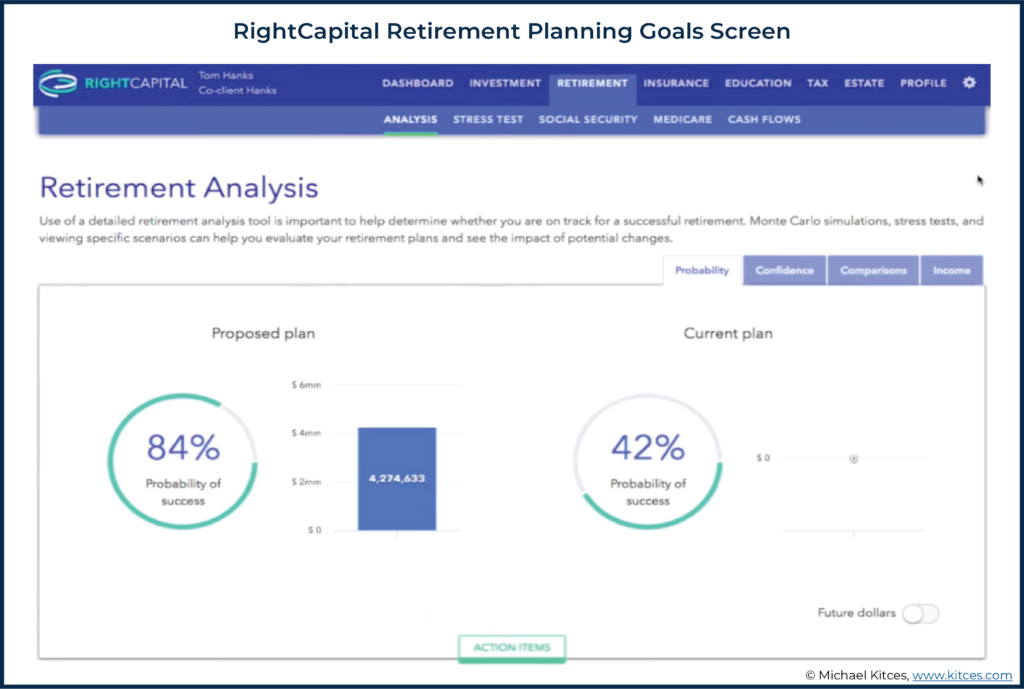
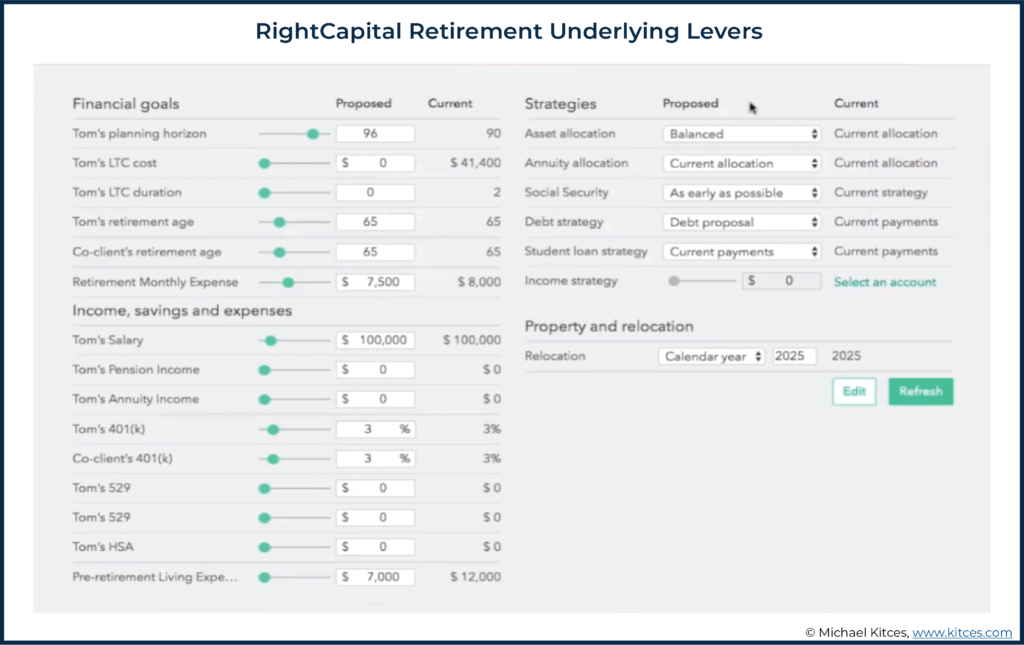
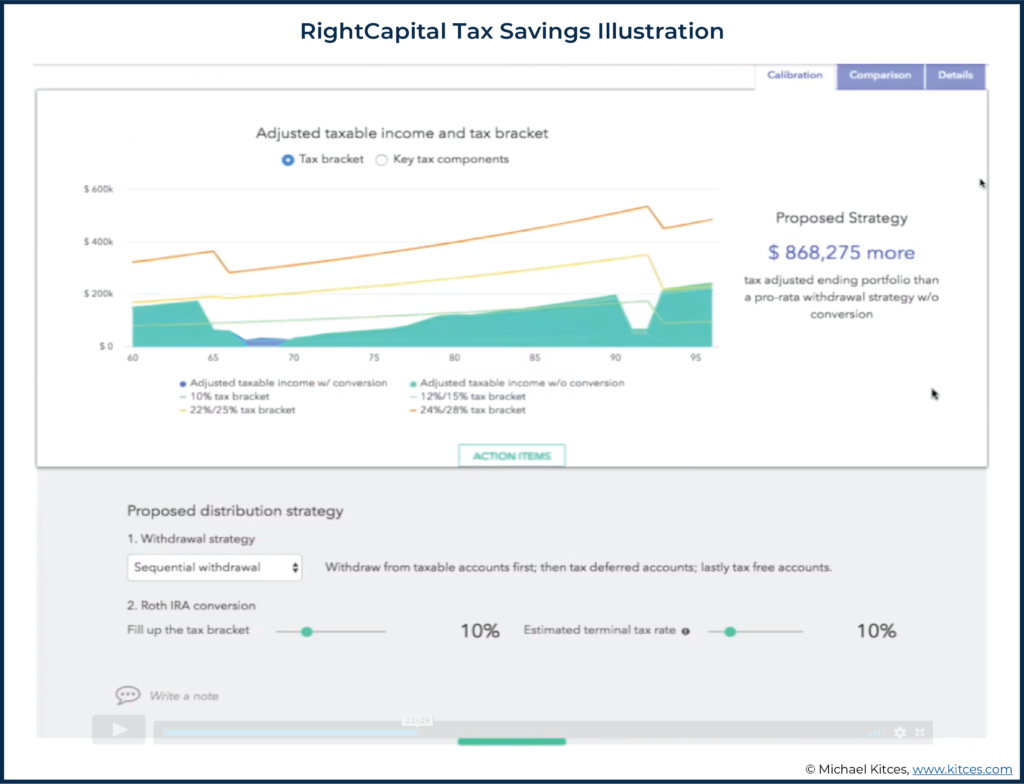
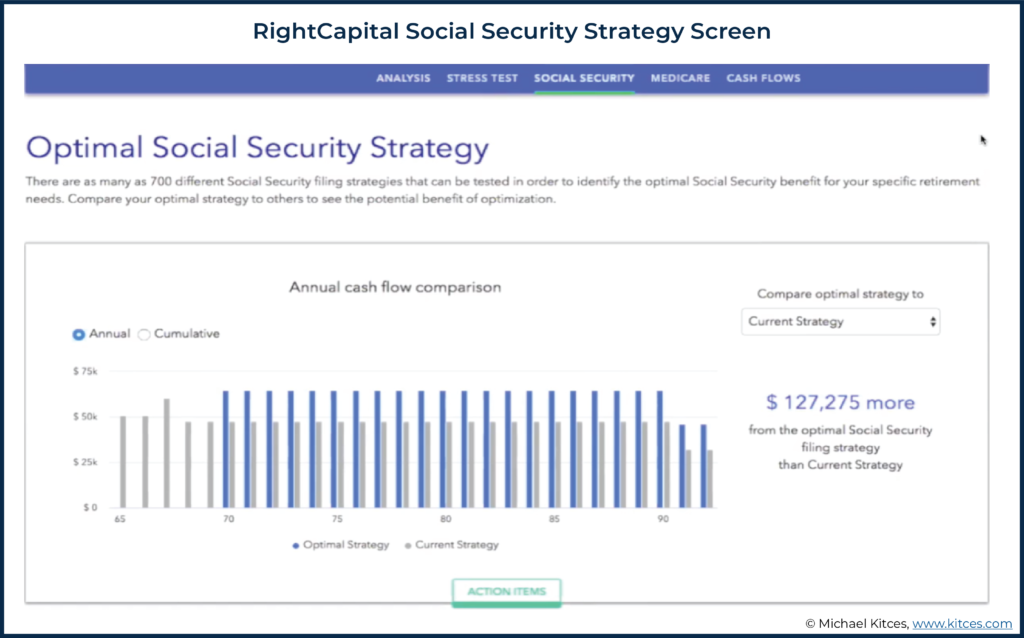
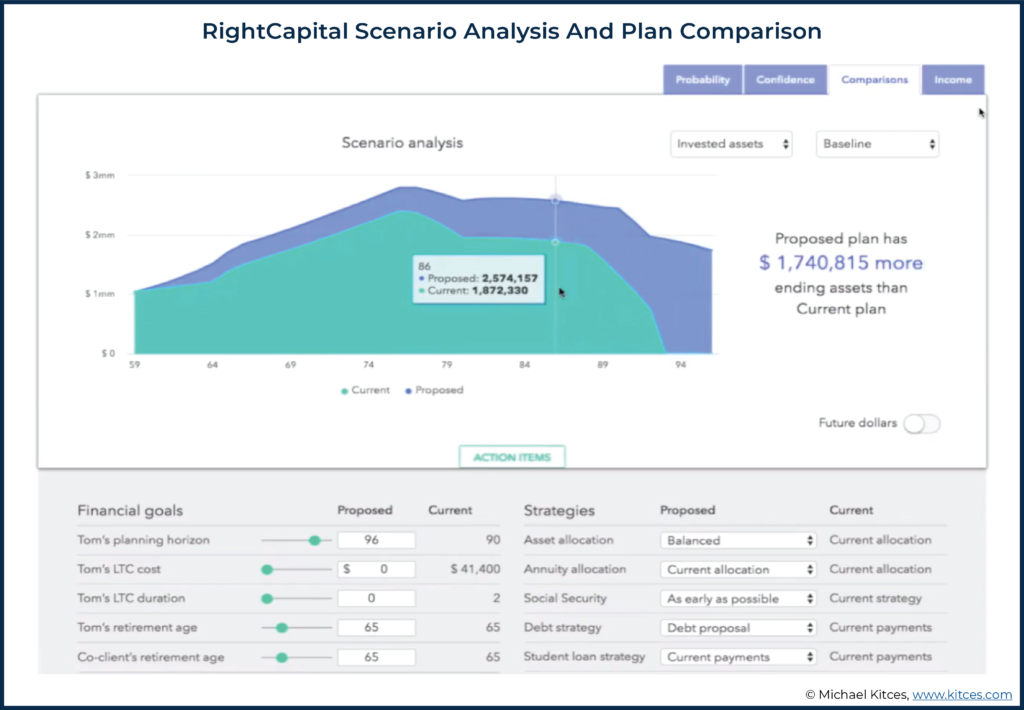
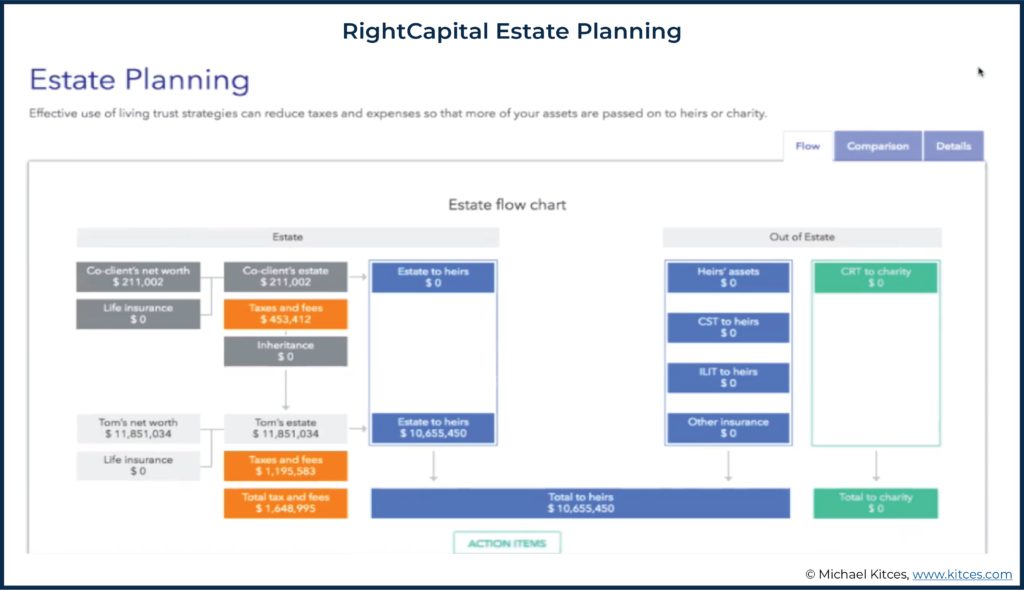
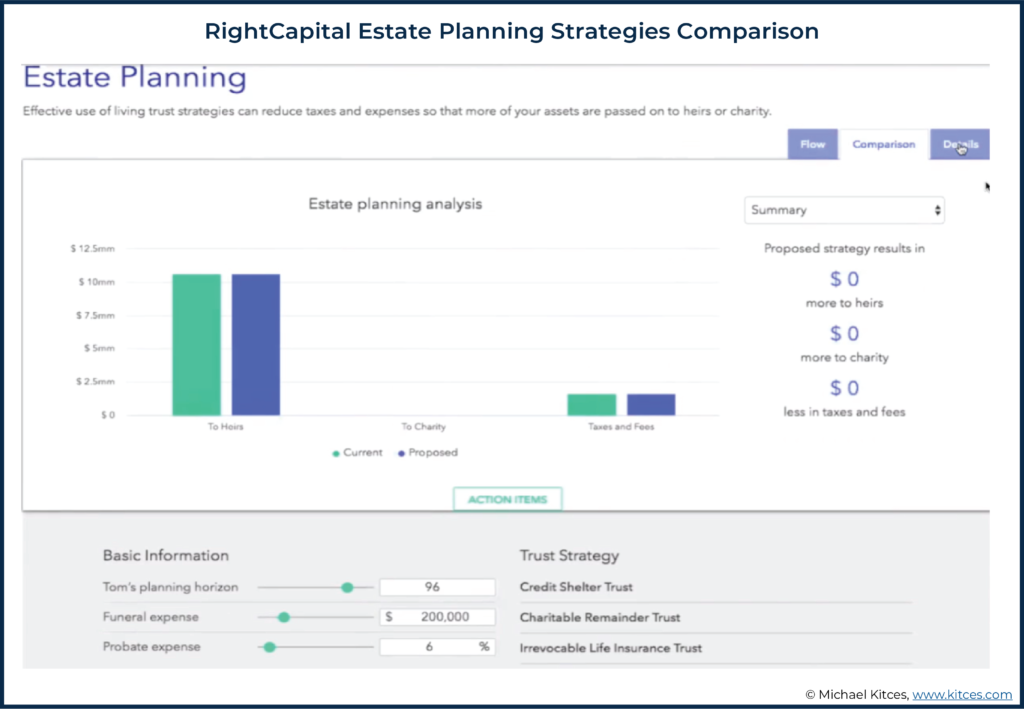
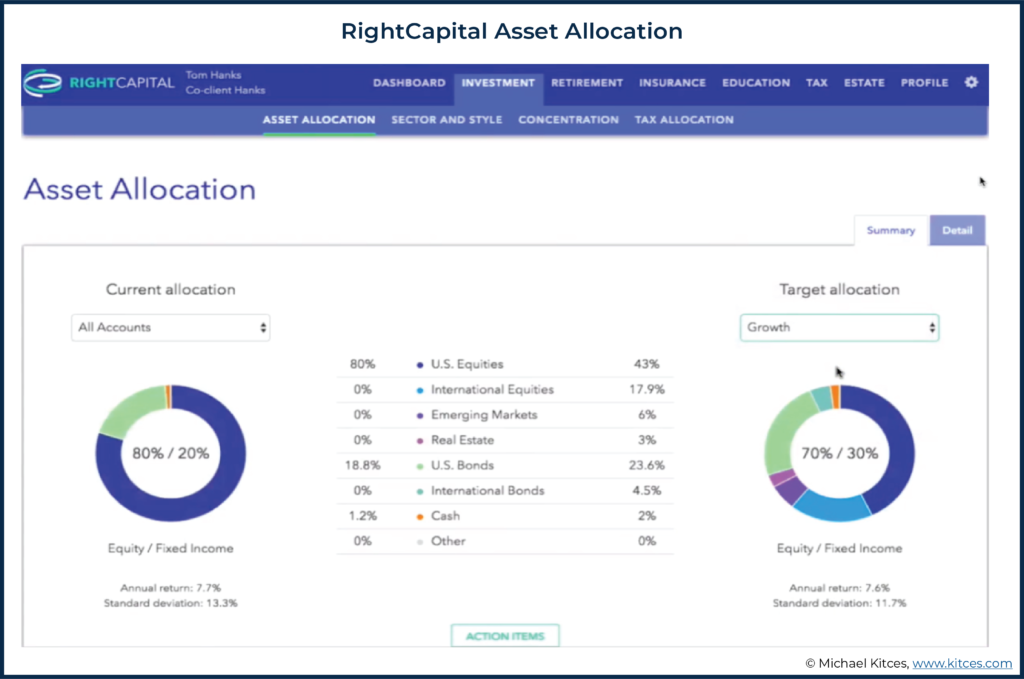
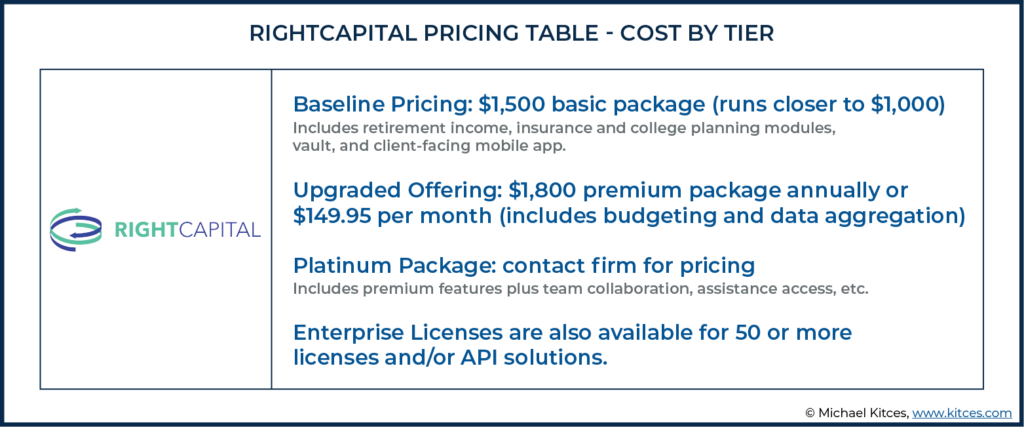

Leave a Reply